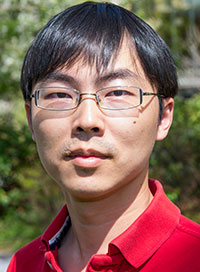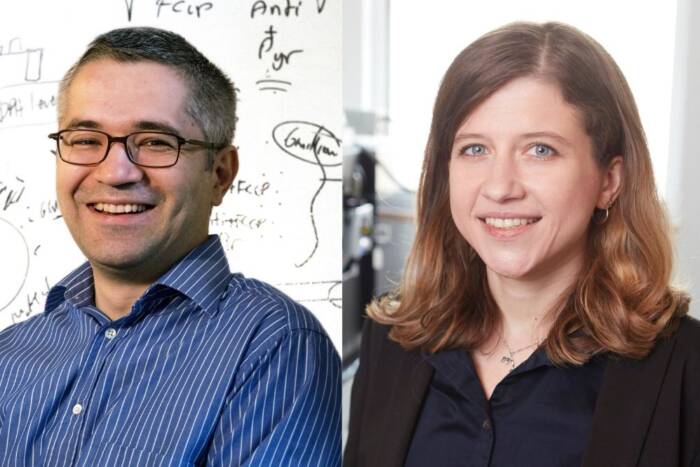One protein's surprising partnership with single-stranded DNA

An artistic representation of the interaction between single-stranded DNA and linker histone H1, featured on the cover of the journal in which the new findings were reported. Credit: Gabriella Chua
To keep order in the tight quarters of the cell nucleus, our DNA is neatly clamped in place around a central disc by H1 linker histone, which helps shepherd DNA into the tidy chromatin fibers that comprise chromosomes. Linker histone, however, is far more than a mere protein clip. Without sufficient H1, the process of gene transcription falters and the intricate dance of DNA repair screeches to a halt. Perched unassumingly atop our nucleosomes, the humble linker histone appears to somehow conduct multiple processes central to genome maintenance.
Now, a new study in Nature Structural and Molecular Biology suggests that linker histone can distinguish between different forms of nucleic acids, with a clear preference for forming condensates with single-stranded DNA over double-stranded DNA. This discriminating feature provides yet more evidence that H1’s role stretches far beyond that of chromatin compaction, and may help explain the protein’s contribution to DNA repair and a number of human diseases.
“This changes the paradigm of H1 function in the cell, and provides a new perspective in understanding different H1 variants and disease-associated mutations,” says Rockefeller’s Shixin Liu, head of the Laboratory of Nanoscale Biophysics and Biochemistry.
Scientists have long suspected that linker histone plays a key role in multiple genomic processes. Besides the evidence that H1 is involved in DNA repair and transcription, the existence of many different types of linker histone in our cells implies an expanded role for the protein. “We wouldn’t need 11 different subtypes of linker histone if its role was purely structural,” says Rachel Leicher, a former graduate student in Liu’s lab who led the study along with one of Liu’s current graduate students, Gabriella Chua.
Motivated by this suspicion, Liu, Leicher, and Chua formed a collaboration with a team from Memorial Sloan Kettering Cancer Center led by Yael David, who pioneered the purification of recombinant linker histone proteins. They leaned on the laboratory’s area of expertise, single-molecule detection and manipulation, to investigate how H1 interacts with DNA up close.
By pulling double-stranded DNA between focused laser beams known as optical tweezers, Liu and colleagues stretched a sample until portions of it melted into single-stranded DNA. Linker histone, to their surprise, flooded the single-stranded region. Further investigations demonstrated that H1 and single-stranded DNA accumulate into a viscous, gel-like droplet, distinct from the more fluid droplet created when H1 reluctantly coalesces around double-stranded DNA. And accompanying computer simulations performed by Bin Zhang’s lab at MIT, as well as cellular imaging of how linker histone operates in the nucleus performed by the David lab, were consistent with the Liu lab’s in vitro findings.
“We did not go in with this hypothesis—our assumption was that H1 would only interact with double-stranded DNA and nucleosomes,” Leicher says. “But when we stretched DNA, we fortuitously observed the accumulation of H1 around the portions of the molecule that had popped into single strands. That was when we realized that H1 not only binds single-stranded DNA, but likes it better than double-stranded DNA.”
Since one feature of DNA damage is the breakdown of double strands into frayed single strands, the findings tie in nicely with H1’s proposed role in DNA repair. If H1 is involved in responding to DNA damage, one would expect it to show a special affinity for single-stranded DNA. The current study focused on one particular H1 subtype, also one of the most abundant. Future studies will investigate how the other linker histone subtypes interact with damaged DNA, continuing to capitalize on the optical tweezer technique that allowed the lab to investigate the material properties of molecular condensates in ways that traditional techniques cannot.
In the long run, a better understanding of linker histone may inform research into several cancers associated with H1 mutations. “Our work opens up a new way to think about the function of linker histone,” Liu says. “It’s not purely an architectural factor, but a protein that plays a diverse and dynamic role. And since we know that H1 mutations can drive some cancers, we’re particularly interested in studying how linker histone impacts genome stability and gene expression.”



